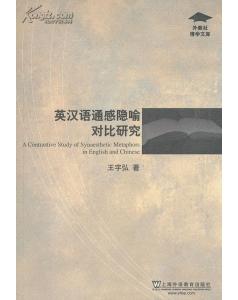 【内容提要】
【内容提要】
本书从通感隐喻角度对人类认知方式的共性和个性做出了进一步的探索。通过对英语和汉语诗歌中的通感隐喻进行大规模的搜集整理和对比分析,探究英汉语通感隐喻源域和目的域之间的搭配关系和迁移方向,发掘出英汉语通感认知模式的共有规律及各自特点,并据此深入剖析通感现象的普遍认知机制,以及通感文化个性的美学和哲学根源。《英汉语通感隐喻对比研究》研究的具体问题包括:(1)英汉语通感隐喻的认知共性;(2)英汉语通感隐喻的文化个性;(3)通感现象的认知机制和认识论启示;(4)英汉民族不同的美学思想和哲学传统对通感认知模式的具体影响。本书由王宇弘著。
【目录】
List of Tables
List of Figures
Abbreviations
Chapter I Introduction
1.1 Terminology
1.2 Motivation of the Research
1.3 Objectives of the Research
1.4 Layout of the Book
Chapter 2 Literature Review of Relevant Research
2.1 Synaesthesia and Literature
2.1.1 Synaesthesia in Western Literature
2.1.2 Synacsthesia in Chinese Literature
2.2 Synaesthesia and Linguistics
2.2.1 Synaesthesia and Rhetoric
2.2.2 Synacsthesia and Semantics
2.2.3 Comparative and Contrastive Studies of Synaesthesia
2.3 Synaesthesia, Psychology, and Cognition
2.3.1 Synaesthesia and Psychology
2.3.2 Synaesthesia and Cognitive Theories
2.4 Summary
Chapter 3 Theoretical Framework of the Study
3.1 Historical Perspectives of the Relationship between
Conception and Perception
3.1.1 Two Basic Orientations Concerning the Origin of Knowledge--Rationalism and Empiricism
3.1.2 The Prelude of Rationalism and Empiricism in the Pre-Socrates Stage
3.1.3 The Formation of Rationalism and Empiricism in Classic Greek Philosophy
3.2 The Kantian Account of Conception and Perception--"the Critique Philosophy"
3.2.1 The Background of the Kantian Philosophy
3.2.2 Perception Conforming to Conception--"Critique of Pure Reason".
3.2.3 A Transcendental Link between Conception and Perception---Schema
3.3 An Embodied Account of Conception and Perception--the"Embodied Philosophy"
3.3.1 The Embodied Realism
3.3.2 The Embodiment of Human Reason
3.3.3 An Embodied Link between Conception and Perception--Image Schema
3.4 Summary
Chapter 4 Research Methodology and Results
4.1 Research Methodology
4.1.1 Research Questions
4.1.2 Materials
4.1.3 Research Design
4.1.4 Procedures
4.2 Research Results
4.2.1 Statistics
4.2.2 General Descriptions
Chapter 5 Synaesthetie Metaphors in English and Chinese: Cognitive Similarities
5.1 Predominant Source and Target
5.1.1 Predominant Source
5.1.2 Predominant Target
5.2 Predominant Type
5.2.1 Hearing-targeting Types
5.2.2 Vision-targeting Types
5.3 Predominant Direction
5.4 Summary
Chapter 6 Synaesthetic Metaphors in English and
Chinese: Cultural Differences
6.1 The Diversity of Synaesthetic Metaphors in English
and Chinese
6.1.1 Cultural Difference in Synaesthetic Sensation
6.1.2 Cultural Difference in Synaestheticity
6.2 Aesthetic Preference
6.2.1 Richness versus Lightness
6.2.2 Aesthetic Preference in the Western Culture
6.2.3 Aesthetic Preference in the Chinese Culture
6.3 Philosophical Root
6.3.1 Troth versus Nature
6.3.2 Philosophical Tradition in the Western Culture
6.3.3 Philosophical Tradition in the Chinese Culture
6.4 Summary
Chapter 7 General Discussion
7.1 On the Cognitive Mechanism of Synaesthesia
7.1.1 Schema-based Synaesthesia
7.1.2 Affection-based Synaesthesia
7.1.3 Concurrence-based Synaesthesia
7.1.4 Interim Summary
7.2 On the Philosophical Significance of Synaesthesia
7.2.1 The Cognitive Role of Synaesthetic Metaphors
7.2.2 The Epistemological Implication of Synaesthetic Metaphors
7.3 On the Methodology of Synaesthetic Studies
7.4 Summary
Chapter 8 Contusion and Impfications
8.1 Summary of Major Findings
8.1.1 Answers to Research Question 1
8.1.2 Answers to Research Question 2
8.1.3 Answers to Research Question 3
8.2 Implications
8.2.1 Linguistic Implications
8.2.2 Philosophical Implications
8.3 Limitations and Recommendations
8.3.1 Limitations of the Present Research
8.3.2 Recommendations for Future Researches
References
Appendices
Appendix Ⅰ: Sample English Entries of Synaesthesia
Appendix Ⅱ: Sample Chinese Entries of Synaesthesia

 新书报道
新书报道